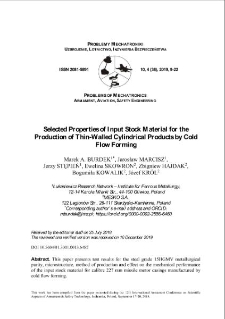Nasza Biblioteka Cyfrowa udostępnia 1 868 obiektów cyfrowych
Obiekt
Tytuł: Selected Properties of Input Stock Material for the Production of Thin-Walled Cylindrical Products by Cold Flow Forming ; Selected Properties of Input Stock Material for the Production of Thin-Walled Cylindrical Products by Cold Flow Forming
Tytuł odmienny:
Wybrane właściwości materiału wyjściowego do wytwarzania cienkościennych stalowych wyrobów cylindrycznych metodą zgniatania obrotowego ; Wybrane właściwości materiału wyjściowego do wytwarzania cienkościennych stalowych wyrobów cylindrycznych metodą zgniatania obrotowego
Współtwórca:
Jarosław MARCISZ, Jerzy STĘPIEŃ, Ewelina SKOWRON, Zbigniew HAJDAK, Bogumiła KOWALIK, Józef KRÓL ; Jarosław MARCISZ, Jerzy STĘPIEŃ, Ewelina SKOWRON, Zbigniew HAJDAK, Bogumiła KOWALIK, Józef KRÓL
Abstrakt:
This paper presents test results for the steel grade 15HGMV metallurgical purity, microstructure, method of production and effect on the mechanical performance of the input stock material for calibre 227 mm missile motor casings manufactured by cold flow forming. The reference product for the determination of preliminary design criteria of missile casings of the higher calibre were calibre 122 mm missiles manufactured in Poland. The final mechanical properties of the casings are a cumulative effect of quenching and tempering and strain hardening during cold flow forming. The research and industrial practice carried out so far have demonstrated that the production process of a Feniks missile (with a 1.5 mm thick casing wall) requires steel grades of extremely high purity. This steel grade is manufactured by VAD (Vacuum Arc Degassing) melting, followed by ESR (ElectroSlag Remelting) or, alternatively by melting and casting in vacuum oven. The content of hard and non-deformable non-metallic inclusions such as oxides is critical to the success of cold flow forming. The calibre 227 mm missile casings feature walls approximately 2.5 mm thick and produced by cold flow forming from a quenched and tempered intermediate product. New material specifications should be developed for this reason to enable correct cold flow forming and contribute to a significant improvement in the cost efficiency of manufacturing. The investigations covered herein were guided by an assumption that the thicker wall sections might make the material specifications applicable to lower-calibre missiles to restrictive and obsolete about calibre 227 missiles. After initial laboratory tests, this hypothesis will be verified in industrial experiments on the production of prototype missile casings from input stock materials varying in metallurgical purity.
;
This paper presents test results for the steel grade 15HGMV metallurgical purity, microstructure, method of production and effect on the mechanical performance of the input stock material for calibre 227 mm missile motor casings manufactured by cold flow forming. The reference product for the determination of preliminary design criteria of missile casings of the higher calibre were calibre 122 mm missiles manufactured in Poland. The final mechanical properties of the casings are a cumulative effect of quenching and tempering and strain hardening during cold flow forming. The research and industrial practice carried out so far have demonstrated that the production process of a Feniks missile (with a 1.5 mm thick casing wall) requires steel grades of extremely high purity. This steel grade is manufactured by VAD (Vacuum Arc Degassing) melting, followed by ESR (ElectroSlag Remelting) or, alternatively by melting and casting in vacuum oven. The content of hard and non-deformable non-metallic inclusions such as oxides is critical to the success of cold flow forming. The calibre 227 mm missile casings feature walls approximately 2.5 mm thick and produced by cold flow forming from a quenched and tempered intermediate product. New material specifications should be developed for this reason to enable correct cold flow forming and contribute to a significant improvement in the cost efficiency of manufacturing. The investigations covered herein were guided by an assumption that the thicker wall sections might make the material specifications applicable to lower-calibre missiles to restrictive and obsolete about calibre 227 missiles. After initial laboratory tests, this hypothesis will be verified in industrial experiments on the production of prototype missile casings from input stock materials varying in metallurgical purity.
Miejsce wydania:
Warszawa
;
Warszawa
Wydawca:
Wojskowa Akademia Techniczna ; Wojskowa Akademia Techniczna
Data utworzenia:
Data złożenia:
Data akceptacji:
Data wydania:
Rozmiar:
Identyfikator:
oai:ribes-88.man.poznan.pl:2563
Sygnatura:
DOI 10.5604/01.3001.0013.6482 ; DOI 10.5604/01.3001.0013.6482
ISSN elektroniczny:
ISSN drukowany:
Język:
Właściciel praw:
Wojskowa Akademia Techniczna ; Wojskowa Akademia Techniczna
Strona początkowa:
Strona końcowa:
Tom:
Słowa kluczowe:
materials engineering, rocket casing, manufacturing ; materials engineering, rocket casing, manufacturing
Kolekcje, do których przypisany jest obiekt:
Data ostatniej modyfikacji:
29 wrz 2025
Data dodania obiektu:
29 wrz 2025
Liczba wyświetleń treści obiektu:
0
Wszystkie dostępne wersje tego obiektu:
https://ribes-88.man.poznan.pl/publication/2875
Wyświetl opis w formacie RDF:
Wyświetl opis w formacie OAI-PMH:
| Nazwa wydania | Data |
|---|---|
| Selected Properties of Input Stock Material for the Production of Thin-Walled Cylindrical Products by Cold Flow Forming | 29 wrz 2025 |
Obiekty Podobne
Paweł BIAŁOBRZEWSKI Judyta SIENKIEWICZ, Jacek JANISZEWSKI, Janusz KLUCZYŃSKI
Marek BURDEK Jerzy STĘPIEŃ, Wojciech WÓJTOWICZ

